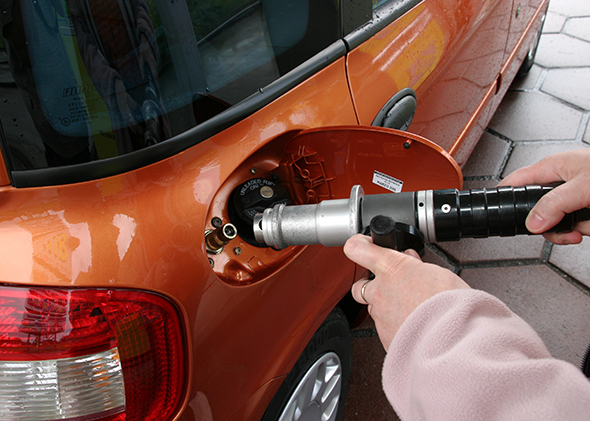
Natural Gas Vehicles Gain Momentum in the U.S.
The incentives are really starting to make sense.

When he goes to visit a client, John Zuk hops into a company car – a Honda Civic. The Civic finds plenty of company on the road – each month, Honda sells about 32,000 Civics, making the modest, reliable car one of the most popular sedans on the market. But the Civic driven by Zuk, vice president of marketing at Philadelphia Gas Works, is a little different – and not just because it is shrink-wrapped in blue with the company’s logo. Rather, a small diamond decal tacked on the back signifies that the car runs on compressed natural gas (CNG).
Philadelphia Gas Works, a city-owned company that serves 500,000 customers, recently bought 24 natural gas-powered Honda Civics from a Pittsburgh-area dealer. The first 15 have been assigned largely to sales and marketing staff and other senior executives. “We bought them to support the market, and because we feel that as a supplier of natural gas [to homes and businesses in Philadelphia], we need to lead by example,” notes Barry O’Sullivan, Director of Corporate Communications at Philadelphia Gas Works. “We’re putting our money where our mouth is.”
Huge new discoveries and the advent of hydraulic fracking have vastly increased the production of natural gas in the U.S. in recent years. Power companies are increasingly substituting natural gas for coal. And natural gas is slowly displacing gasoline as a transportation fuel – especially for fleets of buses and trucks. Omaha, Nebraska, last year rolled out a fleet of 435 buses powered by propane autogas, which is made from natural gas. Delivery service UPS has 965 delivery vehicles that run on compressed natural gas (CNG). Why? While gasoline can cost anywhere from $4.00 to $4.50 a gallon, natural gas costs the equivalent of about $2.00 per gallon in many areas. And it burns much cleaner and produces fewer emissions than gasoline.
According to Navigant Research, about 170,000 trucks and buses that run on natural gas were sold around the world in 2013, and the number is expected to more than double to nearly 400,000 by 2022. But natural gas has yet to emerge in the U.S. as a fuel for passenger vehicles. In fact, natural-gas-powered sedans and coupes remain quite rare. Honda is the only company that produces a sedan that runs solely on natural gas – the Civic. According to Hybridcars.com, Honda in August sold just 46 CNG Civics
The main reason: Car drivers don’t think about the long-term costs of using different types of fuels in the same way that fleet owners do.
At first, potential purchasers of natural-gas powered cars experience a form of sticker shock. It costs more to custom-build these vehicles in small amounts. The Honda Civic that runs on natural gas costs about $6,800 to $7,500 more than the regular version. Truck drivers – who tend to drive very long distances in vehicles that get poor gas mileage – can typically recoup the higher up-front costs associated with natural gas vehicles in the form of lower fuel spending with relative ease. But people who drive cars that already get good mileage may not immediately see the benefits. (Both the regular and CNG Honda Civic get about 30 miles per gallon.)
“People don’t think like fleet managers,” said Brenda Brentano, a senior associate with Gladstein Neadross & Associates, a consulting firm based in Santa Monica that works with Honda on marketing. And individuals are often unaware of other factors and benefits that such cars bring. First, there’s the satisfaction that comes with driving a vehicle with a comparatively low impact on the environment. “It has been certified by the Environmental Protection Agency as having the cleanest internal combustion engine on the planet,” Brentano adds.
There are also other advantages to owning a CNG-powered car. In California, CNG-powered cars have access to HOV lanes, for example. Owning such cars is a sort of insurance policy against higher gasoline prices. And in many states, incentives, tax credits and rebates can effectively lower the cost. O’Sullivan said Philadelphia Gas Works expects that the company will recoup its investments in Honda Civics, which are driven between 12,000 and 15,000 miles per year and use about 420 gallons per year, in about 30 months – largely due to incentives.
There’s another obstacle to the widespread use of natural gas passenger vehicles. While traditional gasoline stations can be found everywhere and are located in convenient areas, natural gas filling stations are few and far between. And many are at corporate facilities that are off limits to the public. As Dave Hurst, an analyst at Navigant put it, “In North America, where natural gas costs remain low, the number of vehicles is outstripping the development of refueling stations.” In Philadelphia, for example, the main CNG fueling station is at an inconvenient location near the Philadelphia International Airport. In July, the first public CNG fueling station in Philadelphia was under construction at a gas station in the northwest part of the city.
Of course, as the offerings of CNG-powered vehicles rise, station owners will have more incentive to build new pumps. And the Honda Civic may soon have company in the market.
In July, Crazy Diamond Performance, a small firm based in Shelby Township, Michigan, about 35 miles north of Detroit, announced it had developed a system that would allow a conventional Chevrolet Cruze – another popular sedan in the same price category as the Civic – to run on natural gas. The company takes a base model (read: low-cost) Cruze, and “then we remove all the gasoline components – the tank, the evaporative system – and replace them,” said Kevin Fern, a founder of Crazy Diamond Performance. Fern believes his offering will appeal to individuals and to corporate fleet purchasers alike. The cost is an extra $8,000, but because the company will be modifying a no-frills Cruze, the final cost will come to about $26,000. Crazy Diamond Performance plans to start production once it receives certification from the Environmental Protection Agency, which is expected in September.
In addition to building vehicles that are fully powered by CNG, other major car manufacturers are starting to offer vehicles that are capable of running on both natural gas and petroleum-based gasoline. General Motors in 2015 will offer a “bi-fuel” version of the Chevrolet Impala, which will have a tank for gasoline and a tank for a natural gas. GM, Ford, and Dodge already sell “bi-fuel” versions of pick-up trucks.
The market for CNG-powered cars remains very much in its infancy—much as the market for hybrid vehicles was 15 years ago, and just like the market for electric or plug-in cars was five years ago. Over the years, in both these areas, competition, growing infrastructure, and enthusiastic users have helped create critical mass. Each month, about 50,000 hybrid cars and about 10,000 plug-in electric vehicles are sold in the U.S. If this pattern continues, a lot of people going to gas stations in 2020 will actually be filling up with natural gas.